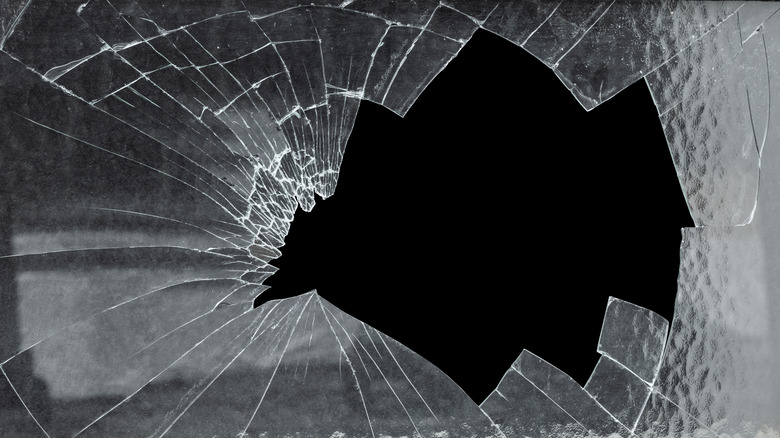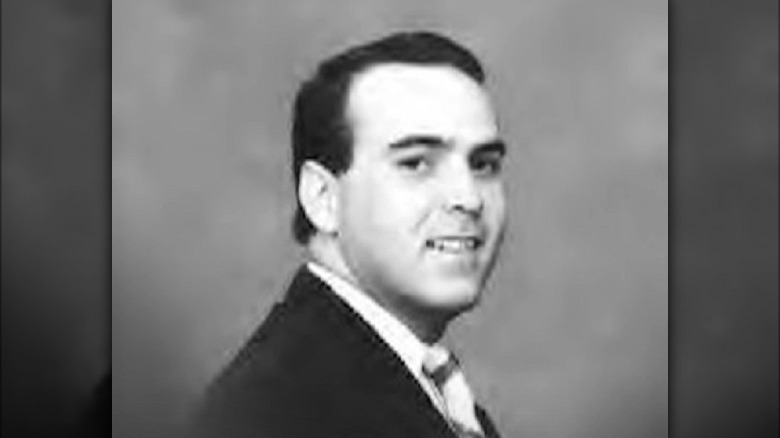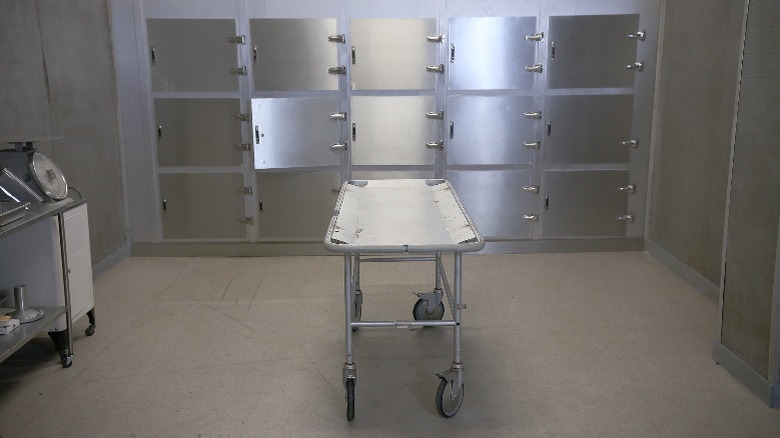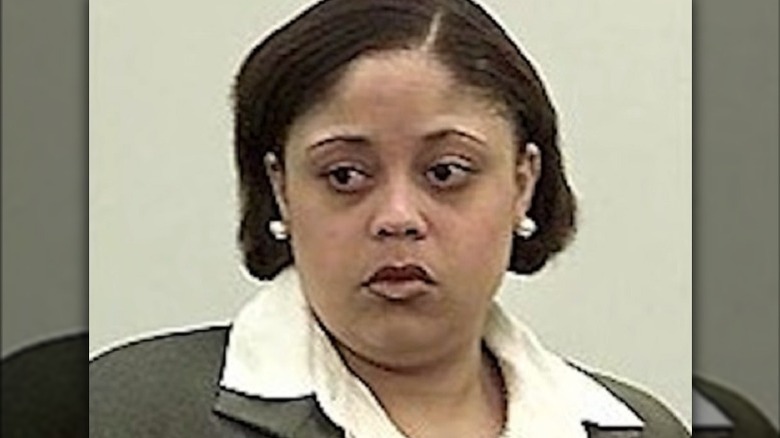The Truth About The Hit And Run Murder Of Gregory Glenn Biggs
Plots in TV shows and movies sometimes seem too good to be true, but in this instance, the case seems so absurd that one might be appalled to learn that it was inspired by true events. Gregory Glenn Biggs' hit-and-run windshield death case inspired the storylines of some of the biggest crime shows, such as "Law & Order," "CSI," and "Fargo," and it showed how a series of bad decisions ended in the tragic death of an innocent man (via People). And it could have all been prevented.
On the evening of October 25, 2001, a 25-year-old nursing aide named Chante Jawan Mallard from Forth Worth, Texas, was enjoying a night of fun at a friend's apartment. Mallard had a few drinks, smoked pot, and took ecstasy before she headed to a nightclub to continue drinking with friends. As reported by Fox News, Mallard left the club at about 3 a.m. and started driving back to her home when she accidentally hit a man. The force was so strong that the man flew through the windshield, and his body was lodged halfway through the glass. Mallard continued to drive home with the man stuck on her windshield, and she parked the car in her garage without helping the victim.
Gregory Glenn Biggs' death
The man that Chante Jawan Mallard hit was later identified as Gregory Glenn Biggs. As a nurse's aide, Mallard knew that Biggs was in dire need of medical attention, but she chose to leave him stuck — injured and bleeding — on the windshield of her car. As reported by Medium, hours went by and Mallard checked on Biggs several times to see his condition, but never once did she help him. Eventually, Biggs died after bleeding out from his severe injuries.
The following day, Mallard sought help from an ex-boyfriend named Clete Deneal Jackson to get rid of Biggs' body. Jackson also called his cousin, Herbert Tyrone Cleveland, and they waited for it to get dark before they started moving. The trio transported Biggs's body to a park and left him there. Afterward, they set fire to parts of Mallard's car in an effort to get rid of the evidence of the hit-and-run incident.
Who was Gregory Glenn Biggs?
Gregory Glenn Biggs, 37, was a homeless man walking along the highway when he was struck by Chante Jawan Mallard. Biggs had gone through a rough time in his life that resulted in his homelessness. According to Medium, the woman with who Biggs was in a relationship with had financial problems, and he decided to loan her money to help. Biggs was a self-employed bricklayer, and he relied on his truck for doing work. However, he wasn't able to make payments, and his truck was eventually repossessed. He also lost his home, as he wasn't able to do work without his truck.
Biggs was also diagnosed with bipolar disorder and schizophrenia, and he was taking medications to be able to live a productive life. With the loss of his income, however, he was no longer able to afford his medication, and his mental instability made it difficult for him to secure a job. At the time of the incident, Biggs stayed at a homeless shelter and worked as a mason. Biggs' mother said that her son was on the way to getting his life back on track when he died, per My Plainview. "He was on an upswing. He was getting back to a good life," she stated.
Gregory Glenn Biggs' injuries
Gregory Glenn Biggs' body was discovered on October 27 at Cobb Park in Fort Worth. Biggs' shoes and socks were missing, and his injuries led detectives to believe that he was a victim of a hit-and-run, as reported by Justia. Blood wasn't present at the scene, which indicated that Biggs' body was moved from the scene of the crime.
An autopsy was performed on the body, and the medical examiner, Dr. Nizam Peerwani, concluded that Biggs died several hours after he was hit. "He couldn't have died instantaneously. There was some interval of time before he died ... We are talking in hours," Peerwani said, per The Washington Post. The autopsy revealed that Biggs' left leg had almost been amputated, which resulted in severe blood loss and his eventual death. His cause of death was listed as "multiple traumatic injuries sustained in auto/pedestrian collision" and the manner of death was homicide.
Chante Jawan Mallard's arrest
Detectives did not have any leads about who was responsible for Gregory Glenn Biggs' death until they received a tip four months later. A woman contacted authorities and said that Chante Jawan Mallard talked about the incident during a party, as reported by CBS News. The caller said that a group was deciding about who would be the designated driver when Mallard giggled and stated she couldn't use her car because she "hit this white man."
A search warrant was obtained based on the information from the tipster, and detectives headed to Mallard's house to arrest her. Reports indicate that she immediately confessed to the crime. There were also pieces of evidence found in her home, including the damaged car in her garage with the seats missing, stains on the floorboard of the vehicle, car seats burnt in the backyard, and a pool of blood on the garage floor. Initially, as reported by Medium, Mallard was charged with failing to stop and render aid, but the charge was later changed to murder and tampering with evidence after the results of Biggs' autopsy came out. The two men who helped Mallard dispose of Biggs' body were also charged with tampering with evidence.
The trial
Chante Jawan Mallard's attorney, Mike Heiskell, said that his client isn't a monster and that she just made a bad decision. "She was simply a frightened, emotionally distraught young woman who had an accident, panicked and made a wrong choice," he stated, per CBS News. According to Lt. David Burgess from the Fort Worth Police Department, Mallard was charged with murder because she could have prevented Gregory Glenn Biggs' death. "There's a pretty good possibility he'd be alive if he'd gotten help, but she concealed the body in the garage," he stated.
Medical examiner Dr. Nizam Peerwani testified in court, and he stated that Mallard's act of continuing to drive the vehicle after the accident further aggravated Biggs' injuries, but he also said that attempting to pull him out would have worsened his condition. It's in his opinion that leaving Biggs inside the garage without medical help contributed to his death (via Justia). Mallard was emotional during the trial, and she apologized to Biggs' family as well as to her own family. "I am so sorry for the crime I've done to society, I really am very sorry," she said, as reported by CNN.
Jury deliberations took less than an hour. They found Mallard guilty of murder as well as tampering with evidence, and she was sentenced to 50 years and 10 years, respectively. She will be eligible for parole in 2027.





